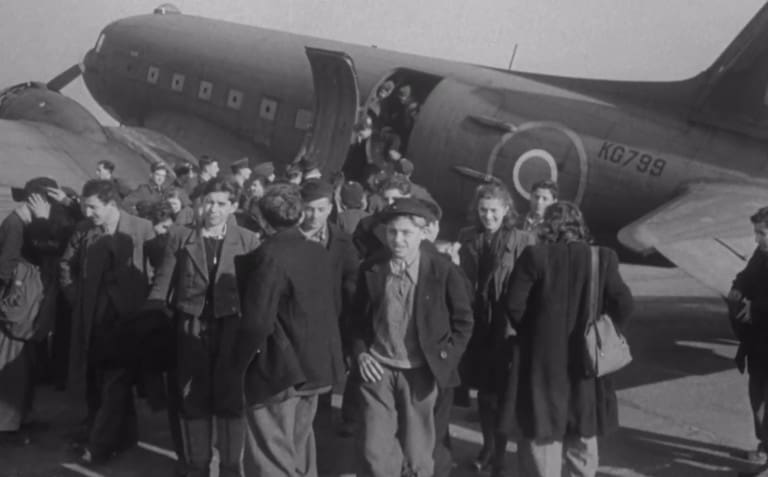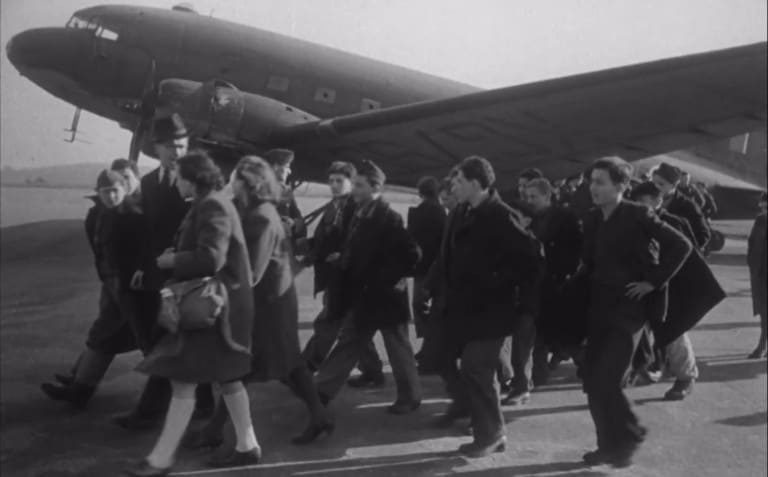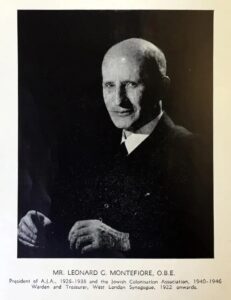 Arrival of the Southampton Boys. Photo: Courtesy of the BFI National Archive.
Arrival of the Southampton Boys. Photo: Courtesy of the BFI National Archive. Arrival of the Southampton Boys. Photo: Courtesy of the BFI National Archive.
Arrival of the Southampton Boys. Photo: Courtesy of the BFI National Archive.The Boys arrived in the UK on a scheme organised by the Central British Fund for German Jewry (CBF), now World Jewish Relief. The CBF had previously managed the rescue of 10,000 mostly Jewish children in the pre-war Kindertransports.
It was Leonard Montefiore, a wealthy philanthropist, who masterminded the plan to bring The Boys to Britain. The scheme he devised was the forgotten final chapter of the Kindertransport.
MONTEFIORE’S MASTERPLAN
 From 1942 onwards, reports of the mass murder of Jews in continental Europe began to reach Britain. As the tide of the war turned against Germany and its allies, the British Jewish community started to plan for post-war relief work. Jewish aid workers began immediately after the liberation to report that some children had survived the Nazi concentration camps.
From 1942 onwards, reports of the mass murder of Jews in continental Europe began to reach Britain. As the tide of the war turned against Germany and its allies, the British Jewish community started to plan for post-war relief work. Jewish aid workers began immediately after the liberation to report that some children had survived the Nazi concentration camps.
In May 1945, Montefiore travelled to Paris to meet with the heads of Jewish organisations. Before returning home, he wrote to the CBF’s chairman Anthony de Rothschild outlining a scheme to bring ‘a few hundred children from Bergen-Belsen or Buchenwald’ to Britain.
On his return to London, Montefiore drew up detailed arrangements of not only how he was going to get the children to Britain, but how he was going to give them the best possible care.
The British government approved his proposal and granted permission for 1,000 child survivors to be brought to the UK. At this point it was believed that no more than 5,000 Jewish children in central and eastern Europe had survived the Holocaust, and those would be cared for in Allied and neutral countries like Sweden and Switzerland, so the Home Office’s offer of 1,000 visas was a fitting response.
That said the offer of help from the British government was not without conditions. The children had to be aged 16 years or under and would be only granted permission to stay in the UK for two years. They were not to cost the taxpayer a penny and the CBF was to be financially responsible for the entire cost of looking after them. The money to do this was to be raised privately. It was later stipulated that only children who had been in concentration camps would be admitted to the UK although the age limit was raised to 18 in 1946.
While in Paris, and later in London the following month, Montefiore met with Joe Schwartz, the European director of the American Joint Jewish Distribution Committee, the JDC. Schwartz was convinced that there was no future for the Jewish people in central and eastern Europe and was keen that the survivors found a new home. For this reason, although the Holocaust had occurred across Europe, the overwhelming majority of The Boys came from these areas.
From early 1945 the JDC had been working with survivors in liberated eastern Czechoslovakia and Schwartz knew that a large number of children and young people had survived in the Theresienstadt ghetto and was looking for a way to get them to safety. The partnership between Montefiore and Schwartz was the first step in what was to become the remarkable story of The Boys.
FINDING THE CHILDREN
To administer the scheme the CBF set up a sub-committee, the Committe for the Care of the Concentration Camp Children. A plan to bring 1,000 children to the UK was one thing but locating and organising an airlift out of Europe was quite another.
In Germany, the initial policy of the Allied-occupying powers was that all child survivors should be moved out of the country but, in the weeks after the liberation, the United Nations Relief and Rehabilitation Administration (UNRRA), the organisation responsible for the care of refugees, felt that it was against the rights of the child to send them to other countries.
UNRRA staff also saw that the children had developed relationships with aid workers and other child survivors, which were vital for children who were the sole survivors of their families and thus they were hesitant to break such bonds.
There was also the question of where these children themselves wanted to go. After the end of the war, survivors who were placed in displaced persons’ camps were asked to register where they would like to be resettled. The overwhelming majority of the children, who were to become the Boys, said they wanted to go to Palestine, as did many Jewish survivors.
The British, who were in control of Palestine at this point, had put in place severe restrictions on the number of Jews allowed to settle there in the 1939 White Paper and these remained in place after the war. Many of the Boys said that, when offered the possibility of going to Britain, they chose to come, as it seemed an option that would eventually take them to Palestine.
THE FIVE GROUPS
The Boys arrived in five groups.
- The first group arrived in August 1945. This group is known as the Windermere Boys and was made up of 301 children.
- The second group arrived in October 1945. This group is known as the Southampton Boys and was made up of 152 children.
- The third group arrived in March 1946. This group is known as the Belgicka Boys and was made up of 149 children.
- The fourth group arrived in June 1946. This group is known as the Paris Boys and was made up of 101 children.
- The fifth group arrived in April 1948. This group is known as the Schonfeld Boys and was made up of 21 children.
MONTEFIORE MAKES A STAND
The economic situation in Britain after the Second World War was extremely difficult and the CBF found raising money a challenge. As a result, although the British government had offered visas for 1,000 children, the CBF could only finance just over 700 child Holocaust survivors.
Despite their financial difficulties, in May 1946, the CBF turned down an offer of assistance from the Peace Pledge Union and the Quakers because Montefiore firmly believed that the child Holocaust survivors needed to be cared for in a Jewish environment.
Montefiore’s commitment was to the children in his care and he made his views clear in the chairman’s report discussed at the committee meeting on 3 June 1946. In the report Montefiore said that if the CBF committed itself to ‘mass immigration’ and the housing of children in large units, that he would resign. Montefiore believed it was more important to care for The Boys already in the UK properly, than to provide inadequate care for hundreds more.
A month later on 4 July 1946, the Kielce pogrom in Poland would kick off a major refugee crisis as thousands of Jewish survivors, among them hundreds of orphans, flooded out of Poland intent on finding a new home in Palestine. That same month, the British decided that they had no choice but to intern in Cyprus those trying to enter the Mandate territory illegally. Hundreds of orphans spent months in terrible conditions on the island.
The minutes of subsequent meetings of the Committee for the Care of the Concentration Camp Children show there was no further discussion of bringing any more children to Britain, and the committee’s Ruth Fellner moved from working on immigration to plans for The Boys’ emigration as their two-year visas were rapidly running out.
Rabbi Solomon Schonfeld, however, continued to look for child Holocaust survivors in eastern Europe and he brought a number of groups of children to Britain. Many of these children became close friends of The Boys and the CBF frequently paid for their up keep. In 1948, Schonfeld brought a group of 148 children from Czechoslovakia. The CBF allocated 21 of these children visas from the original 1,000 quota and they became the fifth group of The Boys.
The Boys
Abisch, Jindrich Abraham, Martin Abraham, Salomon Abrahamovic, Samuel Adler, Arthur Adler, David Adler, Wolfgang Aizen, Chaim Ajzenberg, Jack Ajzykowicz, Ignac Alter, Herman Alterman, Icek Auspitz, William Balsam, Hersch Banach, Jacob Bandel, Mechel Bart, Yankel Basch, Ignac Baumel, Martin Baumelgruen, Isaac Baumohl, Sander Bayer, Jacob Beale, Mendel* Beil, Abraham Bekierman, Shaul Benedikt, Salek Berger, Fischel Berger, Josef Bergermann, Moniek Bergmann, Hersch Berkovic, Frantisek Berkovic, Samuel Berkovitz, Samuel Berliner, Szyja Berlowitz, Jakob Berlowitz, Samuel Bernacki, Chaskiel Beserman, Moses Binenstock, Benek Binke, Schlomo Birnbaum, Moshe Blobstein, Arnost Blobstein, Ludvik Blum, Julius Blumsztajn, Fishel Bogner, Ervin Bomstyk, Majer Borgenicht, David Borgenstein, Samuel Brand, Hersch Brandstein, Issac Brandt, Lazar Brastman, Hersch Brauner, Chiel Braunheim, Solomon Breitburg, Solomon Brenner, Chaim Brenner, Zysel Broch, Abraham Brody, Simon Buchführer, Alfred Buki, Moniek Bulwa, Jacob Bulwa, Abraham Buncel, Erwin Cederbaum, Joseph Chaimovic, Karel Cigelmann, Icik Cohnheim, Avigdor Cwajgenbaum, Szlamek Cygelfarb, Jehoszua Czeret, Arie Czimet, Aranka Czuker, Jan Danzig, Miklos Daudach, Jeno Davidovic, Martin Denderowicz, David Dessau, Kopel Deutsch, Ignac Deutsch, Zoltan Deutsch, Eugene Deutsch, Moses Diamantstein, Julius Diament, Samuel Dicter, Avrom Dreihorn, Berek* Dresner, Samuel Dzialowski, Fajwel Eckstein, David Edelstein, Lazar Elenbaum, Henek Elkienbaum, Abraham Emmer, Manfred Englard, Benek Erreich, Abraham Erreich, Salomon Etkind, Moses Fajman, Salomon Fajngcesycht, Jacob Falinower, Salek Farkas, Arnold Farkas, Efraim Farkas, Jacob Farkas, Jan Farkas, Salomon Feldman, Abraham Felsenfeld, Samuel Ferstendig, Issac Fersztand, Jakob Feuerstein, Herman Fijalko, Josef Finkelstein, Sevek Fischer, Wladislaus Fishelberg, Chiel Fisz, Jurek Fixler, Adolf Flasz, Mechel Frajkorn, Mendel Frank, Peter Freiman, Sam Frenkel, Moniek* Fried, Artur Fried, Desidier Friedman, Arnost Friedman, Moric Friedmann, Alexander Friedmann, Fritz Frischmann, Ladislav Frischmann, Vilem Fruchtzweig, David Frydenberg, Berek Frydenberg, Laib Frydman, Israel Frydman, Nachman Frydman, Simon Frydman, Gershon Fuchs, Joseph Fuks, Jonah Fuks, Chaim Fulop, Yeno Gancz, Anton Gancz, Herman Gasfreund, Israel Gedajlovic, Leo* Geldman, Moses Geller, Chaim Gerstein, Josef Glazier, Henoch Glicksohn, Jacob Goldberg, Szmul Goldberg, Moniek Goldberg, Szmul Goldberger, Jan Goldceckier, Hersch Golde, Heniek Goldschild, Desider Goldstein, Abraham Gontarz, Sam* Grabia, Abraham Graf, Pavel Gross, Samuel Gross, Alexander Gross, Zbyszek Grossman, Israel Grossman, Pinkus Grossman, Josef Gruen, Henryk Gruen, Hugo Gruenberg, Vilem Gruenfeld, Herman Gruenfeld, Otto Grzmot, Motek Gutman, Wolf Gutt, Witold Gutter, Pinchas Haase, Jurgen Hahn, Issy* Halpert, Oskar Halter, Roman Hamburger, Julius Harringer, Peter Hebel, Pinchas Hecht, Martin Hecht, Jacob Heimfeld, Ladislav Hejnochowitz, Abraham Helgfott, Beniek Herman, Abraham Herman, David Herschlikowicz, Mayer Herscovic, Israel Herskovic, Herman Herskovic, Israel Herszberg, Jerzy Herszkowicz, David Herszlikowicz, Arek Herz, Peter Herzberg, Heinz Herzkowitz, Josef Heyman, Manfred Hilf, Chaim Himmelfarb, Wolf Himmelstein, Jan Himmelstein, Josef Hirschfeld, Moniek Hirschfeld, David Hitter, Imre Hochman, Martin Hoffman, Adolf Hoffman, Samuel Holckiener, Samuel Honigwachs, Misa Hopf, Arnost Hornstein, Joseph Hubermann, Abraham Hymans, Alfred Ingielman, Hillel Isaaksohn, Arthur Jacob, Sultan Jacobowicz, Isek Jakubovic, Chaim Jakubovic, Moses Jakubowic, Armand Otto Jonisz, David Josef, Gad Judenschneider, Szlama Judkiewicz, Chaim Junger, Mozes Junger, Samuel Junger, Benjamin Kadysiewicz, Kive Kadysiewicz, Hil Kadysiewicz, Elias Kadzidlo, Moses Kagan, Jack* Kahan, Dezider Kaiser, Eugene Kallos, Gabriel Kalmowicz, Simon Kaminski, Motek Kamionka, Motek Kampel, Fischel Kandelcukier, Kopel Kanitz, Istvan Katz, Bernard Kaufmann, Bernard Kestenberg, David Kirszberg, Abraham Klajman, Jankiel Klajnman, Chemia Klappholz, Kurt Klein, Miklos Klein, Andrej Klein, Avraham Klein, Josef Klein, Tomas Klein, Erno Klein, Sandor Kleinman, Kazriel Kleinman, Lazar Kleinmann, Vojtech Klin, Simon Klotz, Marcus Kochen, Majer Kochen, Ellek Kohn, Hans Kohn, Chaim Kohn, Gabor Kohn, Josef Kolasz, Israel Korman, Chaim Kornfeld, Bernard Koronitzky, Itzhak Koziwoda, Moniek Krowicki, Jacob Kuczer, Szmul Kura, Jacob Kurnedz, Pinkas Kurtz, Jan Kusmiersi, Jacob Kusnirowski, Szaja Kuszer, Binem Kuszerman, Szlama Kutner, David Kutner, Isek Lampert, Moshe Landau, Mathias Lang, Karel Laskier, Schmul Laufer, Abraham Lazarus, Berl Lebovic, Jakub Lebovic, Josef Lebovic, Otakar Lecker, Simon Lee, Michael* Lenczner, Dadek Lewenstein, Motek Lewkowicz, Mordka Lewkowicz, Chaim Lewkowicz, Perez Liberman, Alfred Licht, Israel Lichtenberg, Samuel Lichtenstajn, Josef Liebermann, Moric Liebermann, Simche Lipschitz, Desider Lipschitz, Evzen Lipski, Abraham Liss, Chaim Litwin, Icek Litwin, Mordka Loeffelholz, Salomon Lossau, Joachim Lossau, Max Lossau, Waltraut Luger, Salamon Luger, Herman Luger, Mendel Lustgarden, Moniek Maisner, Abraham Malinicky, Moses Marcovic, Miroslav Markovic, Zdenka Markovic, Moric Markowiecki, Schmul Mauskopf, Erwin Meier, Bruno Meisels, Bela Melzer, Jacob Mermelstein, Simon Mlickiewicz, Mayer Mlynarski, Hersh Moncarz, Jacob Morgenstern, Abraham Moscowicz, Josef Muench, Denys Munkacsy, Tibor Nasch, Bernat Neuman, Jiri Neumann, Emil Neumann, Herman Neumann, Hans Neumark, Joseph Neustaedter, Benek Nisenbaum, Bronislaw Noe, Salomon Nurtman, Bronek Nurtman, Moshe Obuchowski, Berek Oliner, Samuel Olmer, Chaim Oppenheimer, Paul* Orenstein, Salek Orzech, Chaskiel Orzech, Shlomoh Reuven Owichi, Natan Pakula, Josef Palkowic, Armin Pantoffelmacher, Salomon Pawlowski, Abraham Perl, Josef Perl, Salomon Perlmutter, Abraham Perlmutter, Mayer Perlmutter, Izak Pfefferkorn, Eliasz Pietrkowski, David Pinczewski, Moshe Pinkas, Benjamin Pivnik, Sam* Pivnik, Natan* Polak, Vojtech Pomerance, Issac Popiel, Szaja Poznanski, Artek Poznanski, Jerzy Pretter, Mendel Przenda, Jurek Rajzman, Alexander Rajzman, Yitzhak Ratz, Joseph Rayber, Baruch Reichkind, Moshe Reil, Bernard Richter, Leiser Rolnik, Natan Rosenbaum, Moniek Rosenberg, Mendel Rosenberg, Abraham Rosenberg, Chaim Rosenberg, Leon Rosenberg, Vilem Rosenberg, Moshe Rosenblat, Herman Rosenblatt, Zelig Rosenblum, Chaskiel Rosengarten, Samuel Rosenthal, Richard Rosenthal, Alexander Rosenweig, Naftali Rotbaum, Josek Rotenstein, Mendel Rotenstein, Moniek Roth, David Rothman, Benjamin Rothman, Leopold Rothschild, Herman Rotstein, Rywen Rottenberg, Pinkas Eliasz Rozensztrauch, Laib* Rubinfeld, Israel Rubinstein, Abram Rudzinski, Isroel Rudzinski, Kopel Ruzagara, Henrik Salamon, Tibor Salomon, Abraham Schaechter, David Schindler, Alfred Schindler, Max Schnitzor, Josef Rafael Schoenberger, Elias Schottland, Moniek Schulsinger, Abraham Schwarcz, Abraham Schwartz, Alfred Schwartz, Emil Schwartz, Otto Schwimmer, Zisha Seligfeld, Motek Shipper, Zygmunt* Silberstein, Mendel Simkievic, Edek Simkovic, Samuel Slomovic, Chaskel Sommer, David Sosnowicz, Meir Speigel, Estvan Spiegel, Jona Spiro, Chaim Steinbrecher, Emil Steinkeller, Moses Steinmann, Leon Steinmetz, Moses Stern, Tamas Stern, Herman Stern, Meir Strobecki, Jacob Stroh, Peter Sunog, Arnost Svimmer, Chaim Swinik, Aron Swinik, Chaim Szajnzicht, Moniek Szebov, Moric Szlamberg, Chaim Szternfeld, Mietek Szurek, Dan Szwartzberg, Zenek Szyler, Szmul Tabacznik, Motek Tafler, Anton Tarko, Joine Teichmann, Mendel Tenenbaum, Zelik Tennenbaum, Vilem Tepper, Leopold Topel, Mordechai Troper, Jankiel Trzebiner, Salomon Tuch, Moritz Turek, David Vegh, Maurice Vogelhut, Hirsch Wagshal, Leib Wajcenblit, Sevek Wajchendler, Chaim Wajchendler, Herschel Wajnryt, Heniek Waksztok, Menachem Wald, Nathan Waldmann, Joseph Warsaw, Abraham Warszauer, Szmuel Warsznitzer, Hersch Wasserzeicher, Adolf Wegier, Jerzy* Wegner, Harry Weiler, Horst Weinberg, Felix Weinberger, Samuel Weiner, Abraham Weinstock, Roman Weinstock, Herman Weiss, Bernard Weiss, Imrich Weiss, Bela Weiss, Julius Weissbaum, Israel Weisser, Herman Weisser, Michael Wertman, Abraham Widansky, Mosek Wieder, Ignacz Wieder, Lieb Wiernik, David Wiersbicki, Majer Wilder, Israel Winkler, Emil Winogrodzki, Rafael Witelsohn, Wolf Wolff, Gunter Wolfowicz, Benek Wolkowicz, Stephen Wolreich, Abraham Wrobel, Peter Wunzinger, Janko Wurzel, Berek Zaks, Henryk Zaks, Simon Zamel, Hirsch Zelig, Josef Zelikovic, Josef Zelkovic, Hersch Zelkovic, Vili Zelmanovic, Ludwig Zweig, David Zwirek, Abraham Zylberberg, Perec Zylberger, Julek Zylberszac, Aron Zyskind, Hersch